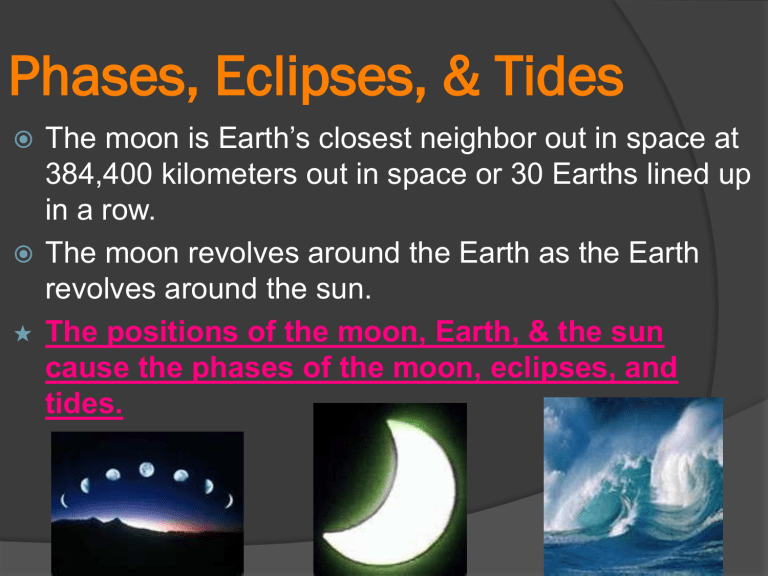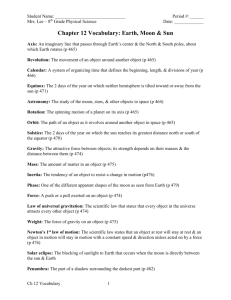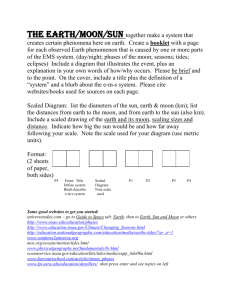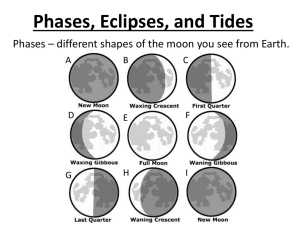Phases, Eclipses, & Tides

Phases, Eclipses, & Tides
The moon is Earth’s closest neighbor out in space at
384,400 kilometers out in space or 30 Earths lined up in a row.
The moon revolves around the Earth as the Earth revolves around the sun.
★ The positions of the moon, Earth, & the sun cause the phases of the moon, eclipses, and tides.
Motions of the Moon:
As the moon revolves around the Earth it rotates on its own axis; its orbit similar to
Earth’s as a flat oval, tilted at about 7˚ .
The moon takes about 27.3 days to orbit around the Earth; it also takes 27.3 days to complete one revolution on its own axis causing a moon “day” & a moon “year” to be the same length of time.
The moon & Earth have synchronous rotation, meaning the same side of the moon always faces
Earth.
The “far side” of the moon always faces away from Earth & is never seen .
Phases of the Moon:
The moon does not produce its own light, instead it reflects the light from the sun.
The moon has 8 phases and goes through the whole set once a month, or
29.5 days.
What Causes Phases?
★ The phase of the moon you see depends on how much of the sunlit side of the moon faces
Earth.
The Cycles of the Phases:
From one full moon to the next it takes about 29.5 days.
The 8 phases of the moon in order are: New
Moon, Waxing Crescent, First Quarter, Waxing
Gibbous, Full Moon, Waning Gibbous, Third
Quarter, Waning Crescent.
Eclipses
★
When the moon’s shadow hits Earth or Earth’s shadow hits the moon, an eclipse occurs.
There are 2 types of eclipses: solar (sun) eclipse & lunar (moon) eclipse.
The type of eclipse is named for what is being blocked from Earth.
Total solar eclipse Total lunar eclipse
Solar Eclipse
The umbra is the darkest and smallest part of the shadow & is cone shaped (total darkness).
The penumbra is the largest part of the shadow
(partial darkness).
Total Solar Eclipse:
○ Only people in the umbra experience a total solar eclipse.
Partial Solar Eclipse:
○ In the penumbra, people only see a partial eclipse ; since part of the sun is still visible, it is not safe to look directly at the eclipse.
Lunar Eclipse
During a full moon the
Earth blocks the sun’s light from reaching the moon making the moon look dark from Earth.
Total Lunar Eclipse
○ When the moon is in the Earth’s umbra, there is a total lunar eclipse
Partial Lunar Eclipse
○ The moon passes partly into the umbra of the
Earth’s shadow .
Do-Now
Come in quietly
Take out notebook. Continue notes from Friday
Answer the following question
Explain the difference between spring tide and neap tides?
When copying notes BLUE IS FOR YOU. Goes in your notebook.
Drawing so have plenty of room in notes. Virtual
Lesson and Exit Slip after.
SPRING TIDES
Spring tides occur at full moon & one at new moon.
The combined force of the sun & moon’s gravity make a tide with the most intense difference between high & low tides.
Spring Tide is the HIGHEST HIGH and the lowest low
DRAW IT
FULL MOON SPRING TIDE
At a full moon the moon and sun are on opposite sides of the Earth. Since they are pulling in a straight line high tides occur. Think of a tug of where the Earth is the prize and both teams are pulling with equal force.
DRAW IT
Spring Tide New Moon
SPRING TIDE- During the New Moon
The Sun, Moon, and Earth are lined up on the same side meaning gravity pulls in the same direction. Think of a tug of war with the Earth in the middle and only one side has a team pulling!
Neap Tides
Neap tides happen 2 times a month, one at first quarter moon & one at third quarter moon.
The Sun, Earth, and Moon form are at right angles and creates tides with the least intense difference between high & low. So HIGH tides are at their lowest and low tides are at their HIGHEST. (It’s like a tug-ofwar between the moon and sun).
Draw It
Neap Tides the Sun’s pull is at a right angle to the Moon’s pull. They pull with similar force causing the higher low tides and lamest, lowest high tides. So the tides are similar in height, not much difference between them.
Motion of Ocean
The moon’s gravity pulls more strongly on the side of the
Earth closest to the moon. This causes high tides
The moon’s gravity pulls more weakly on the water on the far side of the moon causing low tides. As the earth rotates the area with high and low tide changes. There are usually two high tides and two low tides each day.
Low tide
High Tide
Low Tide
The Tide Cycle
The sun is much larger than the moon a baseball compared to a penny! The sun’s gravity affects the tides.
The little moon affects the tides more because it is closer to the Earth and pulls more on the ocean waves.
Tides are causes mainly by differences in how much gravity from the moon and the sun pulls on different parts of Earth
All tides rotate in a cycle.
What are tides
Tides are bulges of water caused by the difference in the pull of gravity.
This pull depends on the position of
Earth, Moon, and Sun







